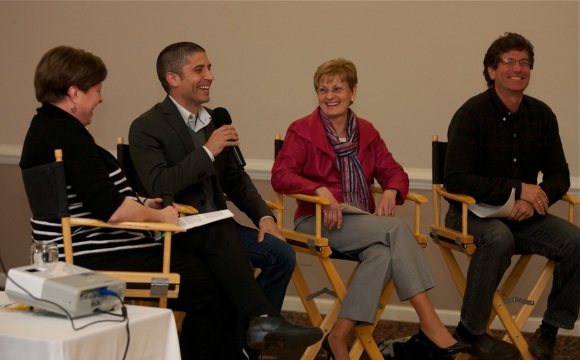A Teacher Reflects on Collaboration (Story)
March 22, 2013
Dr. Joyce Trafton, Art Educator, Bitz Intermediate School, Camp Lejeune, NC
Last evening, I had the privilege of attending the North Carolina Museum of Art’s Educator Expo: Collaboration across Subjects at the Jacksonville Country Club.
Using their unique experiences, a panel of speakers including filmmaker Kenny Dalsheimer, retired president of Onslow Chamber of Commerce Mona Padrick, and NCSU Assistant Professor of Art and Design Mark Russo and moderator Michelle Burrows, A+ Schools Program Director, added many insights into the essential role that collaboration plays in the workplace and must play in our schools. The four break-out sessions further supported the role of collaboration and art integration. Besides just solving problems, collaborative efforts can be made to find problems that need solving. All panelists agreed that for art integration and collaboration to be successful in schools, it has to be a collaborative effort by administrators and teachers to establish such an environment.
There was additional discussion about whether it was essential to arrive at a successful product using the collaborative process or whether the process was more important than the product. In education and in business, I have found that ultimately, a product must be created through process revisitation and adjustment or an individual or team will become frustrated. Furthermore, the business world needs both hard and soft product results in order to create economic success for themselves and our country. The Engineering Design Process (EDP)…ask, imagine, plan, and create…has at its core product realization however circuitous the process. Transforming the imagined into reality is seldom a straight shot.
The collaborative process is sometimes a “slow lane” said Mark Russo, particularly if individuals have seldom been involved in collaboration. First, participants must develop effective communication and interpersonal skills for the process to be successful. In America’s culture of independence and self-reliance, it is sometimes difficult to get diverse individuals to be tolerant of one another’s ideas and their approaches to problem resolution. Thus, collaboration often requires training so that, ultimately, everyone’s “story” is respected.
Recently, as my students and I constructed a concrete alligator bench outdoors, it was evident that many disciplines overlapped, that art was a connection among the disciplines, and that collaboration was essential. Especially shocking to students were the significant roles of mathematics and science for enabling the success of the sculpture. As we continue to design and build our STEAM focused project–a 9-hole putt-putt golf course–we are actually creating a relief sculpture laid out on the ground with each hole offering additional opportunities for creative sculptural ideas. The golf course will require collaboration not only among teachers and students, but also with our military community and professionals, who have the expertise we need to construct a successful course. We will indeed be in the slow lane as we find and resolve endless problems throughout the EDP process. However, we will create a product based on multiple disciplines for our students to enjoy.
As I continue to watch students participate in the STEAM/EDP process, I cannot help but wonder about the roles of work and play. Westerners often create a dichotomy of seemingly opposite words, when in fact, they are complimentary terms. How many times have you heard: “Quit playing and get to work” as though they are opposites? The Okinawan language, Uchinaguchi, has a word, agi-ryu, which means the land of the sea. The land and the sea are not separate–they complement one another; they become one another. Play can be defined as engagement in enjoyable activities just for the sake of amusement or competition. On the other hand, work is an activity requiring strength and ability to do or perform something suggesting foundational knowledge. Consider that when work and play merge, creative possibilities are endless because the process is challenging and enjoyable empowering and motivating individuals and teams to be highly productive. Metaphorically speaking, work-play is the land of the sea—flexible and stabile, divergent and convergent, creative and analytical, as well as challenging and enjoyable.
The collaborative process with integration of the arts blends nicely with STEAM and the Engineering Design Process and is a dynamic way to impact America’s economic well-being.


